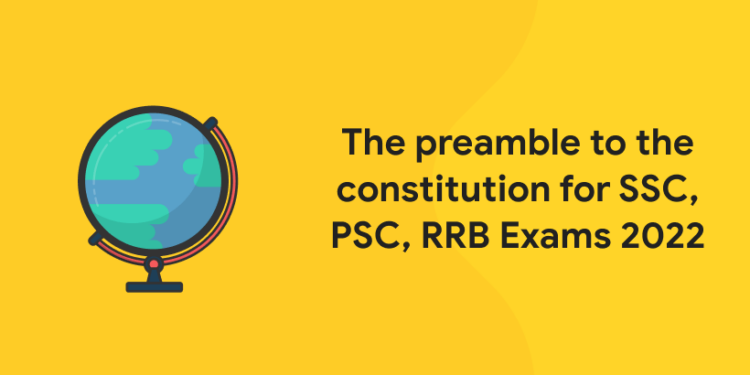Table of Contents
The preamble of the constitution of India expresses the goal that the constitution intends to achieve and affirm, as well as assisting in the legal interpretation of the constitution when the language is unclear. The preamble accurately reflects the concepts included in Pt. Jawaharlal Nehru’s “objective resolution” was submitted to the constituent assembly. It was enacted after the Constitution. The preamble was first used in the United States Constitution. The preamble gives a brief awareness about the following:
(1) the source of the constitution
(2) the nature of India as a nation
(3 its objectives
(4) the date of its implementation
Click here to view the preamble of the Indian constitution PDF
Terms in the preamble of the Indian constitution
- Sovereign: India is sovereign, both internally and externally
- externally free from the power of any foreign nation/organization
- internally, India has a free government that is directly elected by the people and crafts the laws that govern the people.
No external authority can dictate the government of India.
- Socialist: “Socialism” is an economic philosophy where ways of production and distribution are owned by the State. India implemented Mixed Economy, where production is done by both state and private enterprises. Socialism emphasises the importance of social equality and was added to the Preamble in 1976 by the 42nd
- Secular: it means the state has no official religion and all individuals are equally allowed to have the freedom of conscience and have the right freely to profess, practice and propagate their religion. (SR Bommai and Others v/s Union of India). It was included in the Preamble in 1976 by the 42nd
- Democratic: it means that the Constitution has formed a type of government that gets its power from the will of the people. The leaders are elected by the public and are responsible to them.
- Republic: unlike a monarchy, where the head of state is appointed based on the hereditary for a lifetime or until he abdicates from the throne, a democratic republic is a state where the general public elects the head of state, directly or indirectly, for a certain term.
Click here to know more about SSC Exams
Promises of Indian Constitution as stated by the preamble
1: Who was the first woman President of India?
- Justice in Social, Economic and Political fields
- Equality of status and opportunity in every aspect of life
- Liberty means that freedom of thought, expression, belief, faith and worship will be ensured
- Fraternity, which means Brotherhood
Click here to know more about other government exams
Free UPSKILLING Courses!
Take your first step toward mastering in-demand skills, acing interviews, and securing top-tier jobs with Entri's free upskilling courses.
Start Learning!Who designed the Preamble page?
The preamble page, as well as other pages of the original Indian Constitution, were designed and embellished completely by Jabalpur-based painter Beohar Rammanohar Sinha.
Importance of preamble of Indian constitution and its status
The status of the preamble as a part of the Constitution was questioned several times in the Supreme Court in various cases. Read the two cases given below for more understanding.
Berubari Case
It was used as a reference under Article 143(1) of the Constitution in relation to the implementation of the Indo-Pakistan Agreement concerning the Berubari Union and the trading of enclaves, which were decided for consideration by an eight-judge bench. By this case, the Court declared that ‘Preamble is the key to open the mind of the makers’ but it cannot be considered as part of the Constitution. Consequently, it is not enforceable in a court of law.
Kesavananda Bharati Case
For the first time, of 13 membered judges’ bench was assembled to hear a writ petition. The Court declared that the Preamble of the Constitution should be considered as part of the Constitution. It also says that the Preamble is not the supreme authority or source of any restriction or prohibition. Nevertheless, it plays an important role in the interpretation of statutes and provisions given in the Constitution. So, it can be settled that preamble is part of the introductory part of the Constitution.
Union Government Vs LIC of India
This case was conducted in the year 1995. The Supreme Court affirmed that the Preamble is an essential part of the Constitution but it cannot be enforced in a court of justice.
Click here to attempt a mock test on Indian Polity for SSC exams
Amendment of the Preamble
After the verdict of the Kesavanand Bharati case, it was acknowledged that the preamble is part of the Constitution.
- Since the Preamble is a part of the constitution, it can be amended under Article 368 of the Constitution, but it should be done in such a way that the basic structure of the preamble is not amended.
- The only instance in which the preamble was amended was the 42nd Amendment Act of 1976.
- The term ‘Socialist’, ‘Secular’, and ‘Integrity’ were included in the preamble by the 42nd Amendment Act of 1976.
- ‘Socialist’ and ‘Secular’ were included in the middle of ‘Sovereign’ and ‘Democratic’.
- ‘Unity of the Nation’ was altered to ‘Unity and Integrity of the Nation’.
As discussed in the above article, the preamble is an important topic for competitive exams like SSC, TNPSC, KPSC, RRB etc. Download the Entri app to learn more General Awareness Topics included in Indian polity










